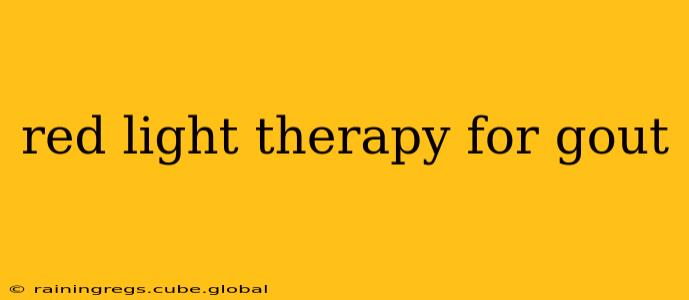Gout, a painful form of inflammatory arthritis, affects millions worldwide. Characterized by sudden, severe attacks of pain, swelling, redness, and tenderness in the joints, primarily the big toe, gout is caused by a buildup of uric acid crystals in the joints. While conventional treatments exist, many are seeking alternative therapies, and red light therapy (RLT) has emerged as a potential option. This comprehensive guide explores the current understanding of red light therapy's role in managing gout symptoms and its potential benefits and limitations.
Does Red Light Therapy Help with Gout?
The effectiveness of red light therapy for gout is still under investigation, and more large-scale, rigorously designed studies are needed. However, preliminary research and anecdotal evidence suggest potential benefits. RLT works by emitting low-level light wavelengths that penetrate the skin, stimulating cellular processes. This may help reduce inflammation, improve circulation, and accelerate tissue repair – all crucial factors in gout management.
The purported mechanisms through which RLT might help with gout include:
- Reduced Inflammation: The anti-inflammatory effects of RLT are well-documented in other conditions. This reduction in inflammation could alleviate the intense pain and swelling associated with gout flares.
- Improved Circulation: Enhanced blood flow to the affected joint can help flush out uric acid crystals and deliver essential nutrients for tissue repair, speeding up the recovery process.
- Stimulation of Cellular Repair: RLT may stimulate the production of collagen and other components crucial for tissue regeneration, potentially leading to faster healing of damaged joint tissues.
What are the Benefits of Red Light Therapy for Gout Pain?
While definitive conclusions require more extensive research, potential benefits based on the mechanisms described above include:
- Pain Relief: Many users report a significant reduction in gout pain after undergoing RLT sessions.
- Reduced Swelling: The anti-inflammatory properties of RLT can contribute to decreased swelling in the affected joint.
- Faster Recovery from Gout Attacks: By improving circulation and stimulating tissue repair, RLT might shorten the duration and severity of gout flares.
What Wavelengths of Red Light are Best for Gout?
The optimal wavelengths for treating gout with RLT are still being explored. However, wavelengths in the red (630-700nm) and near-infrared (NIR, 810-850nm) ranges are commonly used and believed to be effective in promoting tissue repair and reducing inflammation. Many devices offer a combination of red and NIR light. It is crucial to consult with a healthcare professional or a qualified RLT practitioner to determine the most suitable wavelengths and treatment protocol for your specific needs.
How Often Should You Use Red Light Therapy for Gout?
There's no one-size-fits-all answer to how often RLT should be used for gout. The frequency and duration of treatments depend on several factors, including the severity of the condition, the individual's response to therapy, and the type of device used. Generally, multiple sessions over several weeks are recommended, but a healthcare professional or experienced RLT practitioner can provide personalized guidance.
Can Red Light Therapy Prevent Gout Attacks?
While RLT may help manage the symptoms of a gout attack and potentially accelerate recovery, current evidence doesn't definitively support its use in preventing future attacks. Preventing gout attacks primarily focuses on lifestyle modifications like diet changes (reducing purine-rich foods), weight management, and medication as prescribed by a physician. RLT could potentially be a complementary therapy alongside these preventative measures, but further research is needed to confirm its preventative role.
Is Red Light Therapy Safe for Gout?
Red light therapy is generally considered safe, with minimal side effects reported. However, it's crucial to use a high-quality device from a reputable manufacturer and follow the manufacturer's instructions carefully. Individuals with certain medical conditions or those taking specific medications should consult their physician before using RLT.
Conclusion
Red light therapy shows promise as a complementary therapy for managing gout symptoms, particularly pain and inflammation. However, it's essential to remember that RLT is not a replacement for conventional medical treatments. It's vital to consult with a healthcare professional to discuss the appropriate use of RLT as part of a comprehensive gout management plan. Further research is necessary to solidify the effectiveness of RLT for gout and to establish optimal treatment protocols. Always prioritize medical advice from qualified healthcare providers for the diagnosis and treatment of gout.
